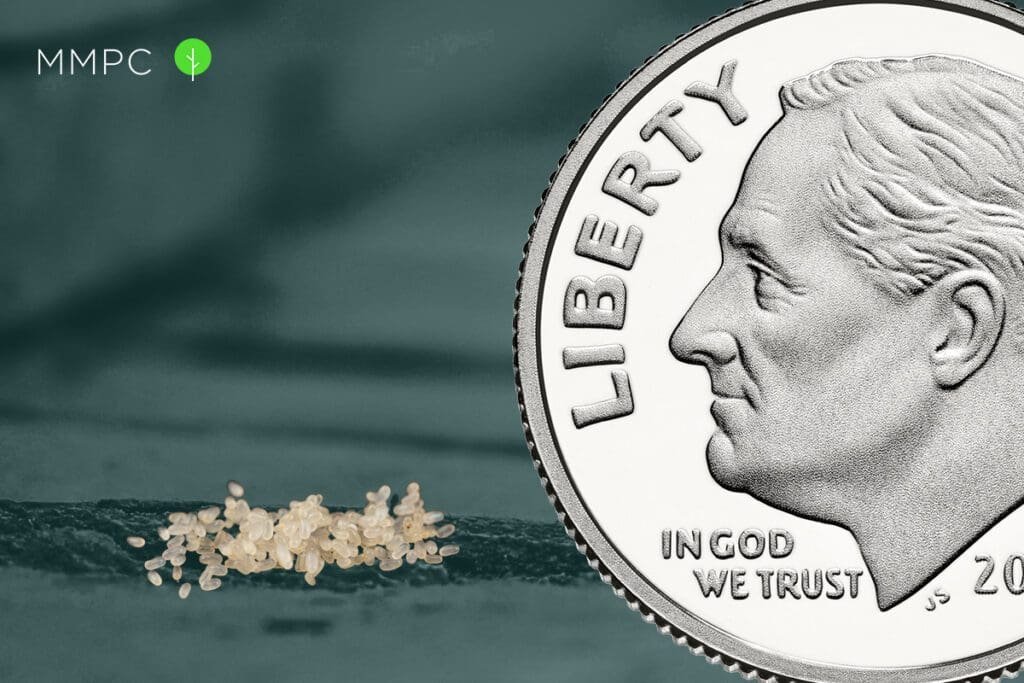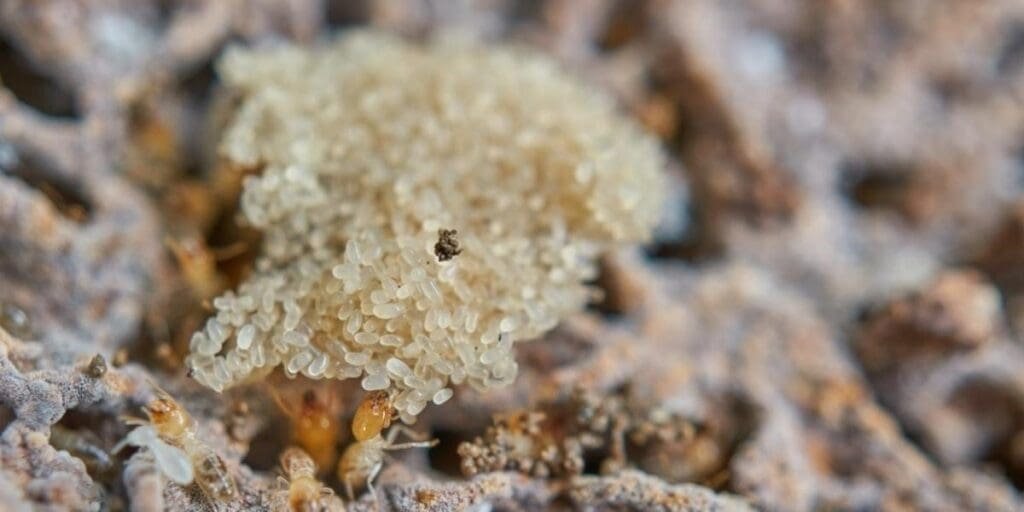
Termite eggs are almost never seen out in the open, and finding them around isn’t a common occurrence. They’re usually located deep within termite colonies inside mud tubes or wooden galleries for protection.
Subterranean termites for example, which are the only type of termite species native to New York, lay their eggs underneath the soil in their underground colonies—not in your house or apartment.
If you find what appears like insect eggs in or around your home, chances are they aren’t termite eggs. But if they are, it could be a sign of a serious termite infestation.
In this article, we’ll explain what termite eggs look like and how to identify them.
What Do Termite Eggs Look Like?
There are several species of termites with different shapes and sizes, as we covered in our article about what termites look like, but termite eggs generally look the same across most termite species.

Shape
Individual termite eggs are shaped like small, white pellets or tiny jelly beans with a shiny, translucent exterior. Unlike bed bug eggs or other insect eggs, termite eggs have no defining dips or dents on their shells.
Termite eggs are laid in large clusters containing hundreds or thousands (depending on the species) of these small, bean-shaped eggs. These egg clusters can look like tiny caviar or a pile of grainy, white powder.
Size
The average size of a termite egg is around 0.5 mm.
After they’re laid, eggs are initially around 0.25 mm in length and can enlarge up to 1.0 mm as the embryonic termite inside develops.
Due to their small size, individual termite eggs are barely visible to the naked eye.
The size of termite egg clusters varies depends on the species of termite and how many eggs the termite queen lays. Termite queens of smaller species, such as subterranean and Formosan termites, can lay thousands of eggs at a time to build enormous colonies with millions of termites.
Color
Termite eggs are pale, translucent, and are usually white or yellow in color (although white is the most common).
The color of termite eggs can vary depending on when they were laid. The first batch of eggs laid by a termite queen tends to be more of a yellowish color, while subsequent batches are typically closer to white or off-white.
In some picture of termite eggs, you might see darker-colored spheres or ovals mixed in with the egg cluster. These are called “termite balls,” which are actually a type of egg-mimicking fungus that steal food meant for the baby termites. Termite balls can be white, yellow, orange, or even brown in color.



Frequently Asked Questions
Where Can You Find Termite Eggs?
Termite eggs are laid deep within the nest and protected by the queen and the worker termites.
Since subterranean termites nest underground, their eggs are typically between 4 to 18 inches below the soil. On the other hand, drywood termites nest in wood, so their eggs can be found inside dead tree limbs, wood beams, wood decks, or wood furniture.
How Many Eggs Do Termites Lay?
Depending on species and habitat, a termite queen in well-established colonies can lay thousands of eggs per day.
The exact number of eggs that a termite queen lays typically correlates with how established the nest is. Initially, the queen will lay only a few eggs at a time. But over time, the rate at which it lays eggs substantially increases.
A termite queen typically lives for up to 25 years, producing hundreds of thousands of eggs annually. This isn’t good news for homeowners, however, especially when a nearby termite colony has more than one egg-laying female.
How Long Do Termite Eggs Take to Hatch?
On average, termite eggs hatch within anywhere between a few weeks to a month, depending on the species and the conditions of the colony.
The climate and geographic location of the termite nest also affect how long it takes for the eggs to hatch. Termites prefer warm or humid conditions to lay their eggs and establish their nests.
What Do Baby Termites Look Like?
After a termite larvae hatches from an egg, it starts in the nymph stage. These baby termites, or nymphs, molt several times before reaching adulthood.
Generally, baby termites look like tiny white ants. They have two antennae that point straight out and a broad waist that helps to differentiate them from baby ants.
As they mature and molt, they gradually start to darken in color.
MMPC: Professional Termite Control in NYC
Since termite eggs are buried deep within termite colonies, they’re difficult to find and to remove on your own. Getting rid of termite eggs also won’t necessarily eliminate an infestation, so if you’re having termite issues, it’s often necessary to consult a professional depending on the size and severity of the infestation.
For termites trouble in New York City or the Tri-State area, MMPC is here to help! We have over 25 years of experience and termite knowledge, which we use to provide reliable termite inspections and treatments.
And if you found insect eggs that you suspect might be termite-related, send us a picture through our Free Pest ID Center and our termite experts will be happy to identify it for you.
